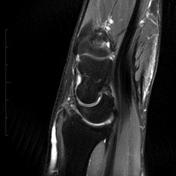Items tagged “wrist”
199 results found
Article
Mayfield classification of carpal instability (perilunate instability)
Mayfield classification of carpal instability, also known as perilunate instability classification (carpal dislocations), describes carpal ligament injuries.
Instability has been divided into four stages 1-2:
stage I: scapholunate dissociation (rotatory subluxation of the scaphoid)
disruptio...
Article
Colles fracture
Colles fractures are very common extra-articular fractures of the distal radius that occur as the result of a fall onto an outstretched hand. They consist of a fracture of the distal radial metaphyseal region with dorsal angulation and impaction, but without the involvement of the articular surf...
Article
Scaphoid fracture
Scaphoid fractures (i.e. fractures through the scaphoid bone) are common, in some instances can be difficult to diagnose, and can result in significant functional impairment.
Epidemiology
Scaphoid fractures account for 70-80% of all carpal bone fractures 1. Although they occur essentially at a...
Article
Palmer classification of TFCC abnormalities
Palmer classification for triangular fibrocartilage complex (TFCC) abnormalities is based on the cause, location, and degree of injury 1:
Class 1 - traumatic injury
a: central perforation of the triangular fibrocartilage (TFC) disc proper
b: ulnar avulsion with or without distal ulnar fractur...
Case
Dorsal intercalated segment instability

Published
22 Sep 2009
59% complete
MRI
Case
Dupuytren contracture

Published
07 Nov 2009
57% complete
Ultrasound
Case
Scaphoid fracture - undisplaced

Published
18 Nov 2009
66% complete
X-ray
Case
Carpal tunnel syndrome

Published
16 Jan 2010
63% complete
Ultrasound
Case
Buckle fracture

Published
02 Feb 2010
66% complete
X-ray
Case
Distal radial and ulnar fractures

Published
07 Feb 2010
60% complete
X-ray
Case
Giant cell tumor

Published
25 Feb 2010
92% complete
X-ray
MRI
Nuclear medicine
Case
Radial styloid fracture

Published
01 Mar 2010
66% complete
X-ray
Case
Rickets - active

Published
12 Mar 2010
41% complete
X-ray
Article
Chauffeur fracture
Chauffeur fractures (also known as Hutchinson fractures or backfire fractures) are intra-articular fractures of the radial styloid process. The radial styloid is within the fracture fragment, although the fragment can vary markedly in size.
Pathology
Mechanism
These injuries are sustained eit...
Article
Dorsal intercalated segment instability
Dorsal intercalated segment instability (DISI) is a form of carpal instability featuring dorsal tilt of the lunate. It occurs mainly after the disruption of the scapholunate ligament and is more often encountered than volar intercalated segment instability (VISI).
Clinical presentation
radi...
Article
Ulnar impaction syndrome
Ulnar impaction syndrome, also known as ulnar abutment or ulnocarpal impaction or loading, is a painful degenerative wrist condition caused by the ulnar head impacting upon the ulnar-sided carpus with the injury to the triangular fibrocartilage complex (TFCC).
Differentiation from ulnar impinge...
Article
Ulnar impingement syndrome
Ulnar impingement syndrome is a wrist condition caused by a shortened distal ulna impinging on the distal radius proximal to the sigmoid notch. The syndrome is distinct from ulnar impaction syndrome, which typically occurs due to a long ulna (positive ulnar variance) impacting upon the triangula...
Article
Ulnar styloid impaction syndrome
Ulnar styloid impaction syndrome refers to wrist pain due to a long ulnar styloid process impacting upon the triquetral bone.
Pathology
An ulnar styloid >6 mm in length is commonly regarded as being long. Impaction results in chondromalacia of the opposing articular surfaces, i.e. the proximal...
Article
Ulnar-sided wrist impaction and impingement syndromes
There are several distinct ulnar-sided wrist impaction and impingement syndromes. Underlying anatomical causes exist for each syndrome, however, repetitive or excessive use of the forearm and wrist can also contribute.
ulnar impaction syndrome: positive ulnar variance
ulnar impingement syndrom...
Case
Ulnar impaction syndrome

Published
29 May 2010
92% complete
MRI







 Unable to process the form. Check for errors and try again.
Unable to process the form. Check for errors and try again.